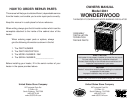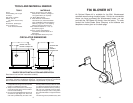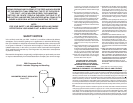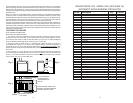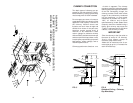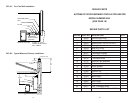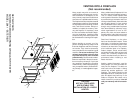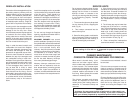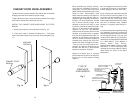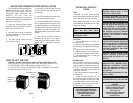
9
When considering a masonry chimney,
round tiles are preferable to square or
rectangular, as round tiles have much
better airflow characteristics and are far
easier to clean. Unfortunately, most
North American chimneys use square or
rectangular tile liners that are really de-
signed for open fireplaces, not stoves or
furnaces. Of most importance, second
only to overall chimney height, is the
diameter of the flue liner itself. In most
instances, it should be sized to the appli-
ance; i.e., 6" flue outlet on the appliance
requires a 6" flue. The inner diameter
should never be less than the flue outlet
diameter and should never be greater
than 50% of the appliance flue outlet. For
example, do not expect a wood burning
stove or furnace to function properly if
installed into a chimney with a flue liner
greater than 50% the appliance outlet -
- such as a 6" flue outlet requires a 6"
diameter for optimum drafting, but can
function well with an 8", but becomes
borderline beyond 8" diameter.
Masonry chimneys built of concrete
blocks without flue liners of at least 5/8"
fireclay do not meet modern building
codes. A
TYPE "A"
FIREPLACE
CONVERSION
Fig. 7
5/8" FIRECLAY
FLUE LINER
STOVEPIPE CONNECTOR
SEALED AT THIMBLE
HORIZONTAL 6" STOVEPIPE
(24 GAUGE) WITH 1/4"
RISE PER FOOT
6" STOVEPIPE ELBOW
CLEARANCE REDUCER
(FOR MANTEL)
6" STOVEPIPE - HAVING
THREE SHEET METAL SCREWS
PER JOINT OF STOVEPIPE
U.L. LISTED
FLOOR PROTECTOR
DAMPER THROAT
CLOSED AND SEALED
solid fuel appliance must not be joined
to a chimney flue which is connected to
another appliance burning other fuels.
If your chimney has a typically oversized
flue liner of 8x12 inches or greater, or if it
is unlined, it will be necessary for you to
reline the chimney, using many of the
modern approved and economical meth-
ods such as stainless steel, castable
refractory, or properly sized fireclay lin-
ings.
If you have any question regarding venting
your appliance, feel free to contact the
factory at the address and phone number
on this Owner's Manual. You may also
contact NFPA (National Fire Protection
Association) and request NFPA Standard
211 (1984 Edition). Their address is
Battery March Park, Quincy,
Massachusetts 02269. Another helpful
publication is NFPA Standard 908,
available at the same address. Specify
1984 Edition on either of the above
publications.
The door knob is mounted inside of the cabinet door to facilitate
shipping and must be reversed for proper usage.
To get cabinet door open, place hand under cabinet frame (right
hand side of cabinet door) and push door out.
INSTALL THE CABINET DOOR KNOB USING THE STEPS
BELOW:
1. Remove the machine screw and door knob (Fig. 10).
2. Place door knob on outside of cabinet door. Then place
machine screw through hole and into door knob and tighten (Fig.
11).
CABINET DOOR KNOB ASSEMBLY
Fig. 10
Fig. 11
CABINET DOOR
KNOB
MACHINE
SCREW
12



